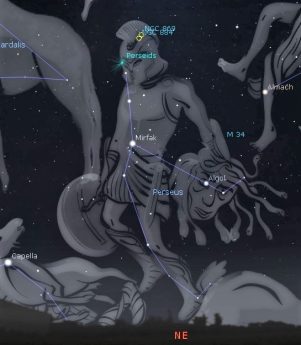This Week’s Sky at a Glance, 2025 August 9 – August 16
This Week’s Sky at a Glance, 2025 August 9 – August 16
With the Perseid meteor shower peaking this week let us visit its namesake constellation. Perseus the Hero stands on the northeastern horizon by midnight, just below the W shape of his mother-in-law, Cassiopeia. He is a hero because, among other deeds, he prevented his future wife Andromeda from becoming a tasty lunch for a ferocious sea monster.
The brightest star in Perseus, Mirfak, is part and namesake of the Alpha Persei Cluster. This is one of my favourite binocular targets because it resembles a miniature version of the constellation Draco. Another popular binocular target is a close pair of star clusters – NGC 869 and NGC 884 – located halfway between Perseus and Cassiopeia, which astronomers have cleverly called the Double Cluster. The Perseid meteors appear to originate from a point near the Double Cluster.
The constellation’s second brightest star is Algol the Demon, representing the eye of the Gorgon Medusa. Perseus beheaded Medusa in a plan to avenge an embarrassing moment by using her head to turn his hecklers into stone. The sea monster was his first victim with this weapon. Algol is famous for dimming by a factor of three every 69 hours. It is a very close pair of stars orbiting each other in our line of sight, and their combined brightness drops when the dimmer star passes in front of the brighter one. Look for the star cluster M34 about a binocular width above Algol.
This Week in the Solar System
Saturday’s sunrise in Moncton is at 6:11 and sunset will occur at 8:37, giving 14 hours, 26 minutes of daylight (6:18 and 8:40 in Saint John). Next Saturday the Sun will rise at 6:20 and set at 8:25, giving 14 hours, 5 minutes of daylight (6:26 and 8:29 in Saint John).
The waxing gibbous Moon is nearing Saturn on Monday and it reaches third quarter near the Pleiades next Saturday. Mars sets shortly after 10 pm this week with Saturn rising soon afterward. Venus and Jupiter have a close conjunction, less than one degree apart, this Tuesday, and the following morning they are still very close with Jupiter above Venus. Mercury rises an hour before sunrise this weekend and it extends that gap to 90 minutes by next weekend. Despite the moonlight, the Perseid meteor shower should delight stargazers over its peak days on Tuesday and Wednesday.
The Saint John Astronomy Club meets in the Rockwood Park Interpretation Centre on August 9 at 7 pm.

